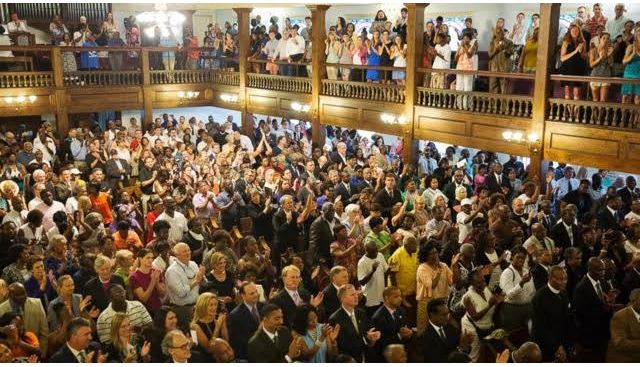Comment on the Charleston massacre

On June 18, mourners gathered at a memorial service for those slain at Emanuel AME church (ABCnews.go.com)
Roof’s shootings at a church was a symbolic attack on the heart and soul of the Black community.
Ralph E. Stone Global News Centre
(SAN FRANCISCO) Everyone has now heard the news that Dylann Storm Roof, a 21-year old white supremacist, is accused of murdering nine worshipers at the historic Emanuel AME church in Charleston, South Carolina. The Rev. Clementa C. Pinckney, the church pastor, was among the dead.
When African-Americans demonstrated against police brutality and racism in Ferguson, Missouri, Baltimore, Maryland, and Oakland, California, they were called “thugs,” “rioters,” and “hoodlums.” But 21-year old Roof, a white supremacist, is being referred to as a “lone wolf” and of course, he must be mentally ill.
A little historic background is needed to place this awful tragedy in context. In 2011, we spent an informative week-long visit to Charleston, South Carolina when the city was observing the Civil War Sesquicentennial (150). We were able to brush up on our Civil War history. That is, mostly from a southern point of view. Remember, Charleston was at one point the largest and most important slave port in North America.
The Sesquicentennial did go out of its way to point out that Charleston’s economic and political power were attained on the backs of thousands and thousands of slaves. As of 1860 the percentage of Southern families that owned slaves has been estimated to be 43 percent in the lower South, including South Carolina. Half the owners had one to four slaves. A total of 8,000 planters owned 50 or more slaves in 1850. According to the 1860 U.S. census, 393,975 individuals, representing 8 percent of all U.S. families, owned 3,950,528 slaves.
Our visit to The Old Slave Mart Museum reminded us of the “why” of the Civil War. It wasn’t really about state’s rights or property rights. (Slaves, of course, were the property in question.) No matter how you spin it, the Civil War was about the abomination called slavery. In 1808, the U.S. banned the international slave trade, but despite government efforts about 250,000 slaves were smuggled into the U.S. from 1808 until the Civil War. And the U.S. ban did not cover slaves born in the U.S.
Charleston was a center for the buying and selling of slaves with about 40 slave marts or auction places. By treating a race or an ethnic group as less than human, enslaving them became easier. That’s basically what happened in slaveholding states. For example, the South Carolina Slave Code of 1740 prohibited teaching a slave to read or write, a slave could not testify in court, and a slave could be executed for plotting to run away. Slaveowners came to view Blacks as lazy, mentally inferior, and naturally promiscuous. Selling away a family member was viewed as only a temporary hardship for the slaves involved. Even religious leaders preached that slaves were born to be slaves, must work hard for their masters, and never disobey, lie or steal.
After the Civil War, South Carolina immediately began to establish Black Codes, which became known as Jim Crow laws after a character in a minstrel show who wore black-face makeup. The laws were merely racism in disguise. The state Constitution of 1865, passed only a few months after the Civil War ended, failed to grant African-Americans the right to vote. It also retained racial qualifications for the legislature. Consequently, African-Americans had no power to combat these unfair laws.
During the time of segregation, South Carolina school districts considered African-American education unimportant. It was illegal for black and white children to attend school together and the state provided little education for African-Americans past the tenth grade. In 1951, the Briggs v. Elliott lawsuit forced the state to address the disparities and problems in funding public education. As a result, South Carolina passed its first statewide sales tax. The money from the 3% tax was dedicated to building and improving schools across the state for both African-American and white students. It was South Carolina’s attempt to build a “separate but equal” school system. Briggs v. Elliott went to the U.S. Supreme Court as one of the five cases decided in Brown v. Board of Education, which struck down these so called separate but equal schools unconstitutional.<
Roof’s shootings at a church was a symbolic attack on the heart and soul of the Black community. The American and Confederate flags fly over South Carolina’s Capitol. The American flag is now flying at half-mast to commemorate these nine African-American lives, but the Confederate still flies high, flapping in the breeze. As its own symbolic act, I suggest South Carolina lower the Confederate flag and toss it on the trash heap of history as a repudiation of its role in slavery, Jim Crow laws, and segregation.
 Global News Centre writer Ralph E. Stone was born in Massachusetts. He is a graduate of both Middlebury College and Suffolk Law School. We are very fortunate to have this writer’s talents in this troubling world; Ralph has an eye for detail that others miss. As is the case with many GlobalNewsCentre.com writers, Ralph is an American Veteran who served in war. Ralph served his nation after college as a U.S. Army officer during the Vietnam war. After Vietnam, he went on to have a career with the Federal Trade Commission as an Attorney specializing in Consumer and Antitrust Law. Over the years, Ralph has traveled extensively with his wife Judi, taking in data from all over the world, which today adds to his collective knowledge about extremely important subjects like the economy and taxation. You can send Ralph an email at this address [email protected]
Global News Centre writer Ralph E. Stone was born in Massachusetts. He is a graduate of both Middlebury College and Suffolk Law School. We are very fortunate to have this writer’s talents in this troubling world; Ralph has an eye for detail that others miss. As is the case with many GlobalNewsCentre.com writers, Ralph is an American Veteran who served in war. Ralph served his nation after college as a U.S. Army officer during the Vietnam war. After Vietnam, he went on to have a career with the Federal Trade Commission as an Attorney specializing in Consumer and Antitrust Law. Over the years, Ralph has traveled extensively with his wife Judi, taking in data from all over the world, which today adds to his collective knowledge about extremely important subjects like the economy and taxation. You can send Ralph an email at this address [email protected]


















 London
London
 Oregon
Oregon





Leave a Reply
You must be logged in to post a comment.